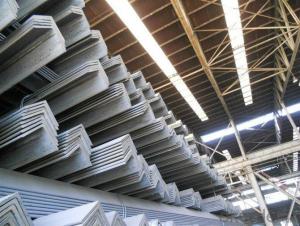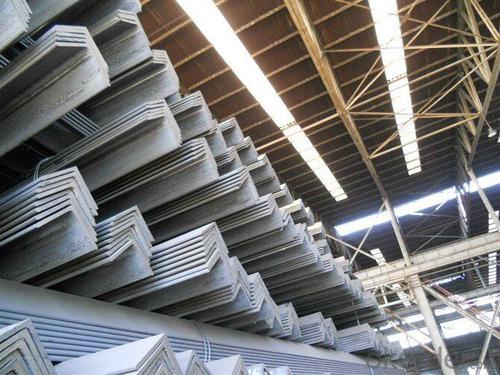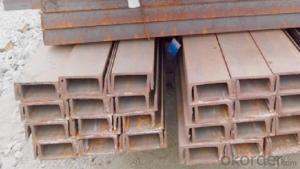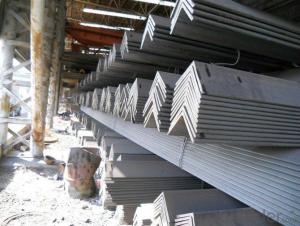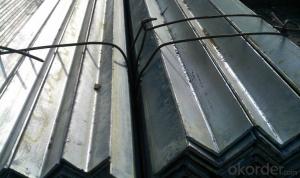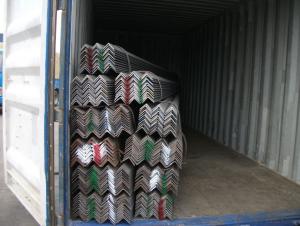2015 Hot Rolled Angle Steel in JIS Standard
- Loading Port:
- Tianjin
- Payment Terms:
- TT OR LC
- Min Order Qty:
- 25 m.t.
- Supply Capability:
- 20000 m.t./month
OKorder Service Pledge
OKorder Financial Service
You Might Also Like
Specification
OKorder is offering high quality Hot Rolled Steel Angle at great prices with worldwide shipping. Our supplier is a world-class manufacturer of steel, with our products utilized the world over. OKorder annually supplies products to European, North American and Asian markets. We provide quotations within 24 hours of receiving an inquiry and guarantee competitive prices.
Product Applications:
Hot Rolled Steel Angles are ideal for structural applications and are widely used in the construction of buildings and bridges, and the manufacturing, petrochemical, and transportation industries.
Product Advantages:
OKorder's Steel Angles are durable, strong, and resist corrosion.
Main Product Features:
· Premium quality
· Prompt delivery & seaworthy packing (30 days after receiving deposit)
· Corrosion resistance
· Can be recycled and reused
· Mill test certification
· Professional Service
· Competitive pricing
Product Specifications:
Manufacture: Hot rolled
Grade: Q195 – 235
Certificates: ISO, SGS, BV, CIQ
Length: 6m – 12m, as per customer request
Packaging: Export packing, nude packing, bundled
Sizes: 25mm-250mm | ||
a*t | ||
25*2.5-4.0 | 70*6.0-9.0 | 130*9.0-15 |
30*2.5-6.6 | 75*6.0-9.0 | 140*10-14 |
36*3.0-5.0 | 80*5.0-10 | 150*10-20 |
38*2.3-6.0 | 90*7.0-10 | 160*10-16 |
40*3.0-5.0 | 100*6.0-12 | 175*12-15 |
45*4.0-6.0 | 110*8.0-10 | 180*12-18 |
50*4.0-6.0 | 120*6.0-15 | 200*14-25 |
60*4.0-8.0 | 125*8.0-14 | 250*25 |
FAQ:
Q1: Why buy Materials & Equipment from OKorder.com?
A1: All products offered byOKorder.com are carefully selected from China's most reliable manufacturing enterprises. Through its ISO certifications, OKorder.com adheres to the highest standards and a commitment to supply chain safety and customer satisfaction.
Q2: How do we guarantee the quality of our products?
A2: We have established an advanced quality management system which conducts strict quality tests at every step, from raw materials to the final product. At the same time, we provide extensive follow-up service assurances as required.
Q3: How soon can we receive the product after purchase?
A3: Within three days of placing an order, we will begin production. The specific shipping date is dependent upon international and government factors, but is typically 7 to 10 workdays.
Alloy No | Grade | Element (%) | ||||
C | Mn | S | P | Si | ||
Q235 | B | 0.12—0.20 | 0.3—0.7 | ≤0.045 | ≤0.045 | ≤0.3 |
Alloy No | Grade | Yielding strength point( Mpa) | ||||
Thickness (mm) | ||||||
≤16 | >16--40 | >40--60 | >60--100 | |||
≥ | ||||||
Q235 | B | 235 | 225 | 215 | 205 | |
Alloy No | Grade | Tensile strength (Mpa) | Elongation after fracture (%) | |||
Thickness (mm) | ||||||
≤16 | >16--40 | >40--60 | >60--100 | |||
≥ | ||||||
Q235 | B | 375--500 | 26 | 25 | 24 | 23 |
Images:
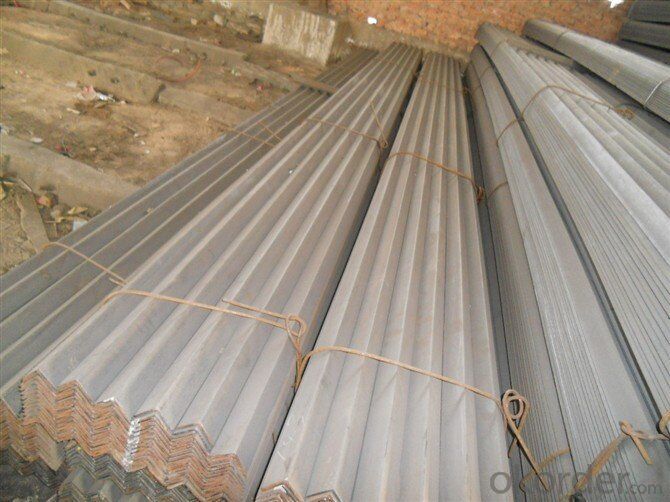
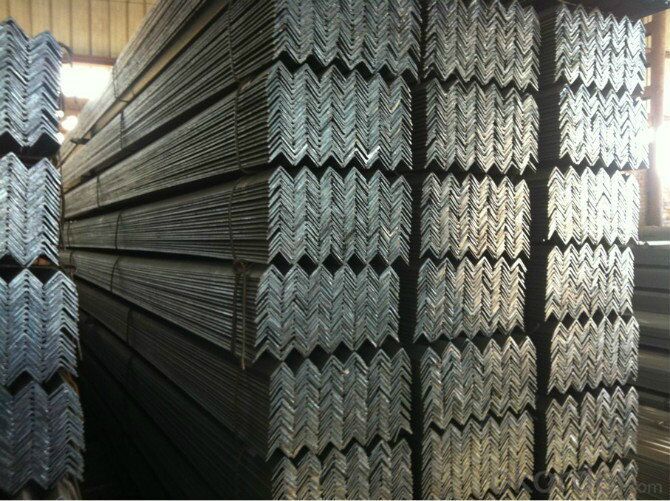
- Q: Can steel angles be used as supports for signage or lighting fixtures?
- Yes, steel angles can be used as supports for signage or lighting fixtures. Steel angles are commonly used in construction and can provide strong and sturdy support for various applications, including signage and lighting fixtures.
- Q: How do you calculate the moment of resistance for a steel angle?
- To calculate the moment of resistance for a steel angle, you need to consider the properties of the angle section and its dimensions. The moment of resistance is a measure of the ability of the angle to resist bending. The formula to calculate the moment of resistance is: Moment of Resistance = Plastic Section Modulus × Yield Strength of Steel The plastic section modulus can be determined using the following formula: Plastic Section Modulus = (Width × Thickness^2) / 6 In this formula, the width refers to the distance between the outer edges of the angle, and the thickness refers to the thickness of the angle section. The yield strength of the steel is a material property and can be obtained from its specification or reference material. It represents the maximum stress the steel can withstand without permanent deformation. By substituting the values of the plastic section modulus and the yield strength of the steel into the formula for the moment of resistance, you can calculate the value. It is important to note that the dimensions used in the calculations should be in consistent units, such as millimeters or inches, depending on the units used in the yield strength value. This calculation provides an estimate of the moment of resistance for a steel angle and is useful in structural engineering applications to determine the capacity of the angle section under bending loads.
- Q: Can steel angles be used as reinforcements in concrete structures?
- Certainly! Reinforcements in concrete structures can include steel angles. Due to their exceptional strength and durability, steel angles are commonly utilized in concrete structures. These angles are placed within the concrete to provide additional support, preventing cracking or failure when subjected to heavy loads or stress. Steel angles offer versatility and are easily incorporated into the designs of various concrete structures, such as beams, columns, walls, and slabs. They are often combined with other reinforcement materials, like steel bars or mesh, to enhance the overall strength and stability of the concrete structure. The preference for steel angles arises from their ease of installation, cost-effectiveness, and ability to withstand the harsh environmental conditions typically encountered in construction projects.
- Q: Can steel angles be used for soundproofing applications?
- Steel angles are not typically used for soundproofing applications. Soundproofing materials are chosen based on their ability to absorb, dampen, or block sound waves. Steel angles, being a rigid and reflective material, do not possess these sound-dampening qualities. Instead, materials such as acoustic foam, mass-loaded vinyl, or soundproof drywall are commonly used for soundproofing purposes. These materials are specifically designed to absorb or block sound waves, helping to reduce noise transmission between spaces. Therefore, while steel angles may have various applications in construction and engineering, they are not suitable for soundproofing purposes.
- Q: What is the weight of a standard steel angle?
- The weight of a standard steel angle can vary depending on its size and thickness. However, in general, a standard steel angle weighs approximately 2.5 pounds per foot (or 3.3 kilograms per meter). This weight is based on a standard steel angle with equal legs and a thickness of 1/4 inch (or 6.35 millimeters). It is important to note that the weight may differ slightly based on the specific dimensions and specifications of the steel angle being used.
- Q: How do you protect steel angles from weathering?
- To protect steel angles from weathering, there are several effective methods that can be employed. The most common approach is to apply a protective coating or paint specifically designed for steel surfaces. This coating acts as a barrier, preventing moisture and oxygen from coming into direct contact with the steel and thus reducing the chances of rust formation. It is essential to choose a coating that is weather-resistant and provides long-term durability. Before applying the protective coating, it is crucial to thoroughly clean the steel angles to remove any dirt, grease, or existing rust. This can be done through abrasive cleaning methods such as sandblasting or using a wire brush. After cleaning, the surface should be primed with a corrosion-resistant primer, which enhances the adhesion of the protective coating. Regular maintenance is also essential to ensure the ongoing protection of steel angles from weathering. This includes inspecting the coating periodically for any signs of damage or wear and promptly addressing any issues that arise. Touching up areas where the coating has been compromised is necessary to maintain the integrity of the protective layer. Moreover, proper design and installation techniques can also contribute to protecting steel angles from weathering. Ensuring that the angles are adequately sealed and protected from direct exposure to rain, snow, or other moisture sources is vital. This can be achieved through proper drainage systems, such as gutters or downspouts, to redirect water away from the steel angles. Lastly, considering alternative materials or coatings that are inherently resistant to weathering, such as stainless steel or galvanized steel, can provide an added layer of protection against environmental elements. These materials have a higher resistance to corrosion and are more suitable for outdoor applications where weathering is a concern. By implementing a combination of protective coatings, regular maintenance, proper design, and utilizing weather-resistant materials, steel angles can be effectively protected from weathering and maintain their structural integrity over an extended period.
- Q: Can steel angles be used in the construction of hotels?
- Yes, steel angles can be used in the construction of hotels. Steel angles are commonly used in construction due to their durability, strength, and versatility. They can be used for a variety of purposes in hotel construction, such as supporting structural beams, reinforcing concrete slabs, framing walls, and creating architectural features. Steel angles provide stability and structural integrity, making them ideal for high-rise buildings like hotels. Additionally, steel angles are cost-effective and readily available, making them a practical choice for hotel construction projects.
- Q: What are the different types of steel angles connections for roof trusses?
- There are several different types of steel angle connections that are commonly used for roof trusses. These connections are designed to provide strong and stable support for the trusses, ensuring the structural integrity of the roof. One common type of steel angle connection is the gusset plate connection. This involves using steel plates, typically in a triangular shape, to connect the various members of the truss at their intersection points. The gusset plates are usually welded or bolted to the steel angles to create a secure connection. Another type of steel angle connection is the angle cleat connection. In this type of connection, steel angles are used to connect the truss members using bolts or welding. The angles are typically bolted or welded to the top and bottom chords of the truss, providing additional strength and stability. A third type of steel angle connection is the angle clip connection. This involves using steel clips or brackets to connect the truss members at their intersection points. The clips are typically bolted or welded to the steel angles, creating a strong and secure connection. Finally, there is the angle bracket connection. This type of connection involves using steel brackets or brackets to connect the truss members. The brackets are typically bolted or welded to the steel angles, providing a reliable and sturdy connection. Overall, there are various types of steel angle connections that can be used for roof trusses, each offering different advantages and characteristics. The specific type of connection used will depend on factors such as the design requirements, load-bearing capacity, and construction methods.
- Q: What is the typical corrosion rate of galvanized steel angles?
- The corrosion rate of galvanized steel angles can vary depending on several factors, such as environmental conditions, exposure to corrosive agents, and the quality of the galvanized coating. However, galvanized steel angles are generally recognized for their excellent corrosion resistance properties. The zinc coating on the steel acts as a protective barrier, preventing the underlying steel from contacting corrosive elements like moisture and oxygen. Under normal atmospheric conditions, the corrosion rate of galvanized steel angles is approximately 1-5 microns per year. This rate can be further reduced in less aggressive environments or with the use of additional protective coatings or maintenance practices. Moreover, in dry or non-corrosive environments, galvanized steel angles can exhibit even lower corrosion rates. It should be noted that in more severe or highly corrosive environments, the corrosion rate of galvanized steel angles may accelerate. These environments may include high humidity, exposure to saltwater, acidic or alkaline conditions, or industrial atmospheres with high levels of pollutants. In such cases, it is advisable to seek advice from corrosion engineers or experts to determine the appropriate corrosion protection measures or alternative materials that may be more suitable for the specific application.
- Q: What is the typical size range for steel angles?
- Steel angles can vary in size depending on the application and industry. Generally, they are available in widths ranging from 20 to 200 millimeters (mm) and thicknesses ranging from 3 to 20 mm. The length of steel angles can also vary, typically ranging from 3 to 12 meters. These dimensions allow for a wide range of applications, including structural support in construction, machinery manufacturing, and architectural uses. It is worth mentioning that while these size ranges are common, there may be variations and custom sizes available based on specific project requirements.
Send your message to us
2015 Hot Rolled Angle Steel in JIS Standard
- Loading Port:
- Tianjin
- Payment Terms:
- TT OR LC
- Min Order Qty:
- 25 m.t.
- Supply Capability:
- 20000 m.t./month
OKorder Service Pledge
OKorder Financial Service
Similar products
Hot products
Hot Searches
Related keywords
